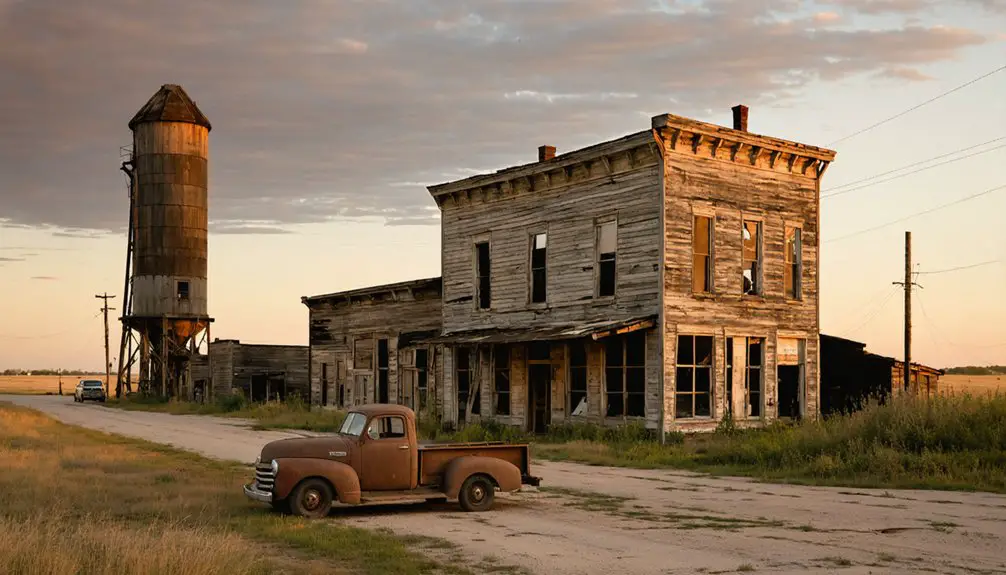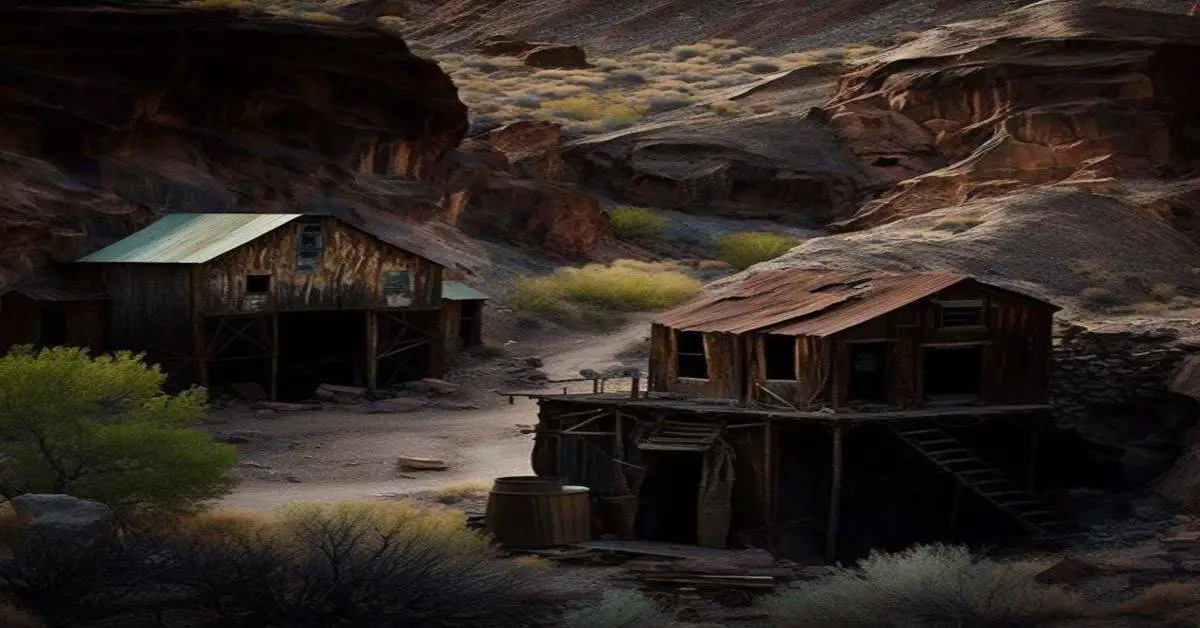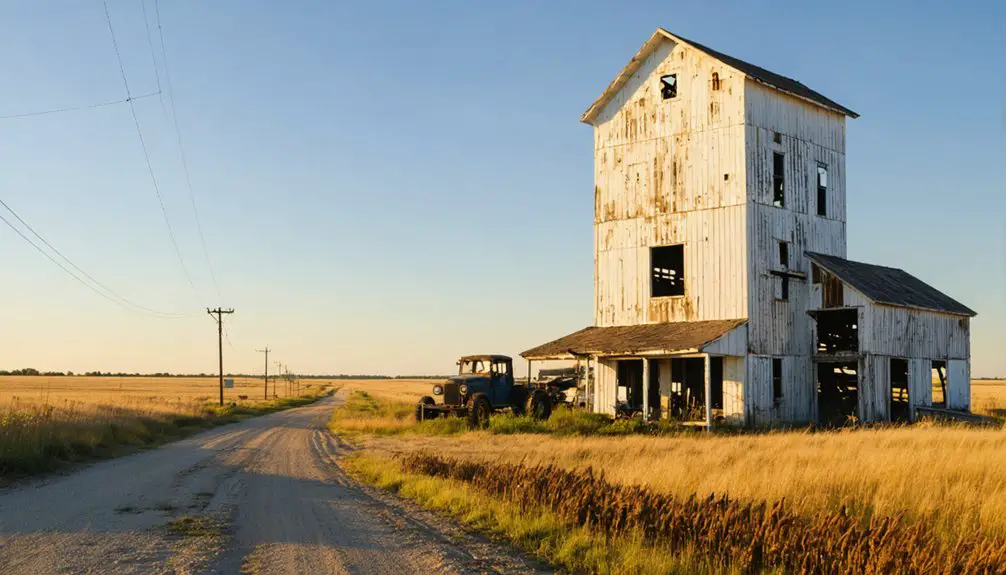You’ll discover Wheelock’s story began in 1902 as a promising railroad town in North Dakota’s Badlands, where settlers from Minnesota and South Dakota built a thriving community of 400 residents. From its bustling commercial district with banks, stores, and a four-classroom schoolhouse, the town’s fortunes shifted dramatically. By the 1970s, only 24 residents remained, and after its official dissolution in 1994, Wheelock’s dark history and haunting legends continue to echo through its abandoned streets.
Key Takeaways
- Founded in 1902 as a railroad town, Wheelock grew to 400 residents before declining to just 24 people by the 1970s.
- A series of violent crimes, including mass murders and bank robberies, contributed to the town’s dark reputation.
- The town’s decline paralleled the shift from rail to highway transportation and challenging agricultural conditions.
- Wheelock officially dissolved in 1994, though BNSF trains still pass through the abandoned town site.
- Now considered one of North Dakota’s most haunted locations, with remaining structures serving as remnants of its past.
The Birth of a Railroad Town
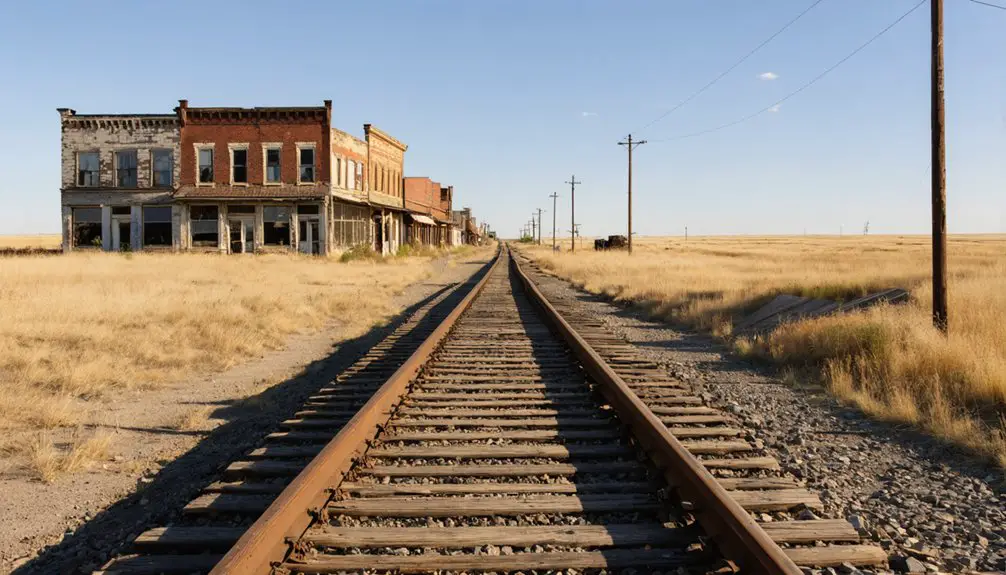
As the Great Northern Railway carved its transcontinental path across North Dakota in 1902, the town of Wheelock emerged from the prairie alongside its steel rails.
You’ll find its origins tied to Ralph W. Wheelock, a Minneapolis Tribune writer who championed the region’s potential, drawing settlers primarily from Minnesota and South Dakota.
The railroad advantages were clear – you’d have immediate access to markets and transportation in this strategic location in eastern Williams County.
Settler motivations centered on the promise of prosperity, with Wheelock’s position along the major rail line offering economic opportunities that vacant prairie couldn’t match.
The railroad brought more than transportation – it delivered dreams of wealth to those seeking fortune in frontier towns like Wheelock.
In fact, the town became so desirable that some settlers had to establish the nearby town of Epping when they couldn’t secure property in Wheelock.
The town would eventually be disincorporated in 1994, marking the end of its official status as a municipality.
Dark Tales From the Badlands
While Wheelock’s birth promised prosperity along the Great Northern Railway, its history would be forever darkened by chilling tales of violence and tragedy.
You’ll find dark folklore woven through the town’s brief existence, marked by two mass murders, a deadly bank robbery, and a lover’s vengeful crime. The haunted encounters reported in Wheelock’s deteriorating structures echo its violent past, where a disturbing message – “forgive me, for I’m insane” – still sends shivers down visitors’ spines.
Near the northern edge of the Badlands, where the Lakota called it Maco Sica, Wheelock’s ruins stand as evidence to humanity’s darker nature. By the 1970s, only 24 residents remained, leaving behind empty buildings and whispered stories of a town whose promise dissolved into ghostly legend.
Life in Early Wheelock
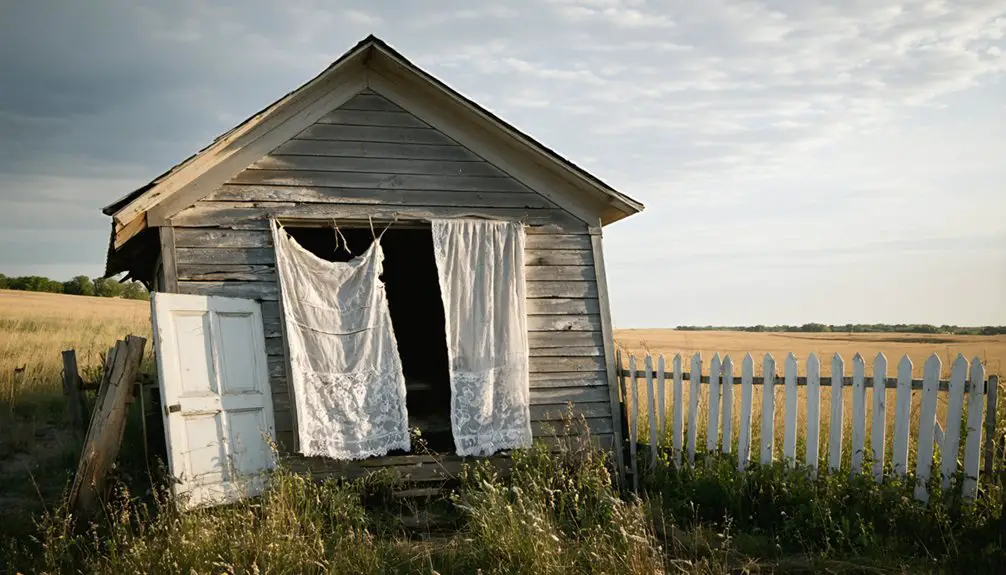
When Wheelock emerged along the Great Northern Railway in 1901, its early residents discovered a relatively affluent prairie community shaped by Northern European immigrants.
You’d find families from Minnesota and South Dakota drawn to the promise of prosperity, despite the typical settler hardships of prairie life. With property values soaring, you could witness a bustling town center where farmers and merchants carved out their futures amid the stark Dakota landscape.
Community traditions reflected the town’s Scandinavian and Germanic roots, as neighbors gathered to support one another through harsh winters and challenging harvests.
While some settlers found Wheelock’s high land prices too steep and moved to nearby Epping, those who stayed built solid homes, barns, and businesses.
Your daily life would revolve around agriculture, railroad commerce, and the tight-knit social bonds that defined these frontier settlements.
The Rise and Fall of Commerce
You’d find Wheelock’s early commercial district bustling with activity, as the town’s strategic railroad location attracted a bank, hardware store, lumberyard, and drug store by 1901.
The railroad’s presence proved essential for commerce, connecting Wheelock to critical trade routes and drawing settlers from Minnesota and South Dakota who saw promising business opportunities in the growing prairie town.
While this commercial prosperity initially set Wheelock apart from neighboring communities, making it larger and more affluent, the town’s dependence on the railroad would eventually contribute to its downfall.
Business District Peak
The commercial heart of Wheelock reached its zenith in the early 1930s, when approximately 115 residents called this bustling prairie town home.
You’d have found remarkable business diversity along its streets, from general stores and various shops to a prominent church that served both townspeople and surrounding farmers. The town’s commitment to community engagement was evident in its four-classroom schoolhouse with a gymnasium, representing significant local investment.
The Great Northern Railway line proved essential to Wheelock’s prosperity, facilitating freight movement and passenger travel that kept commerce flowing.
Local merchants thrived by serving the needs of both town residents and area ranchers, while agricultural ventures, including regional cotton ginning operations, helped sustain the town’s economic vitality during its peak years.
Railroad’s Economic Impact
Along the Great Northern Railway‘s transcontinental line, Wheelock sprang to life in 1902, marking the beginning of its rail-driven prosperity.
You’ll find that railroad influence shaped every aspect of the town’s early development, from attracting Minnesota and South Dakota settlers to establishing crucial commercial links with distant markets.
At its peak, Wheelock’s economic sustainability thrived on its strategic position as a switching location, with the population reaching 115 by 1930 and reportedly growing to 400 by the 1950s.
The railroad’s presence fueled local commerce, enabling farmers to ship grain and livestock while merchants received essential supplies.
But as rail transport declined in favor of highways, you’ll notice how quickly fortunes changed.
Haunting Mysteries and Local Legends
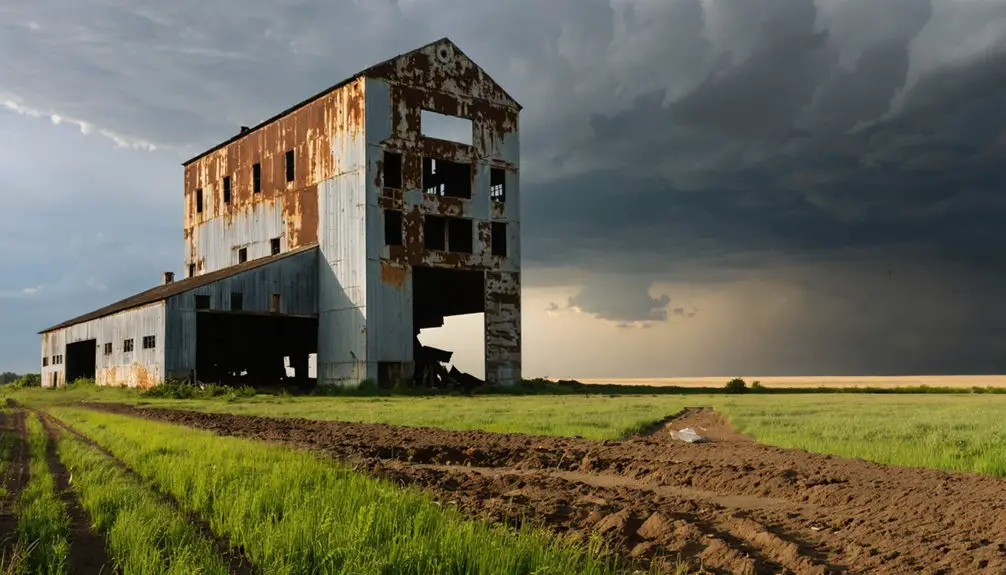
Haunted by its violent past and multiple tragic deaths, Wheelock’s reputation as a paranormal hotspot continues to captivate ghost hunters and local historians alike.
Wheelock stands frozen in time, its dark history echoing through abandoned streets where restless spirits still wander.
You’ll find stories of spiritual encounters linked to early 1900s mass murders, including a chilling bank robbery and a disturbed killer who left an eerie note confessing his insanity.
The region’s unsettling history aligns with Lakota Sioux beliefs about ancestral spirits dwelling in this part of the Badlands, or “Maco Sica.”
Reports of ghostly apparitions range from murdered victims to unsettled infant souls, while the railroad’s violent legacy adds another layer to the supernatural tales.
Despite Wheelock’s official dissolution in 1994, these haunting mysteries persist, drawing curious visitors to this desolate ghost town in search of paranormal activity.
Architecture and Remaining Structures
Beyond the paranormal tales, Wheelock’s architectural remnants tell their own compelling story of time’s passage.
You’ll find several original buildings still standing – homes, churches, and shops – though they’re slowly surrendering to North Dakota’s harsh elements. The town’s layout centers around the still-active BNSF railway tracks, a reflection of its railroad heritage.
Recent years have seen significant architectural decay, with the grain storage facility, general store, and old school falling to demolition or fire.
While building preservation efforts occasionally surface, like the church’s 2018 listing for $75,000, most structures continue their gentle descent into ruin.
The wood-frame buildings, typical of early 1900s rural architecture, now wear peeling paint and weathered facades, creating a poignant snapshot of small-town American history frozen in time. Among the most prominent features of the townscape is the original schoolhouse, which has endured since the town’s founding in 1902.
Historical Events That Shaped Wheelock
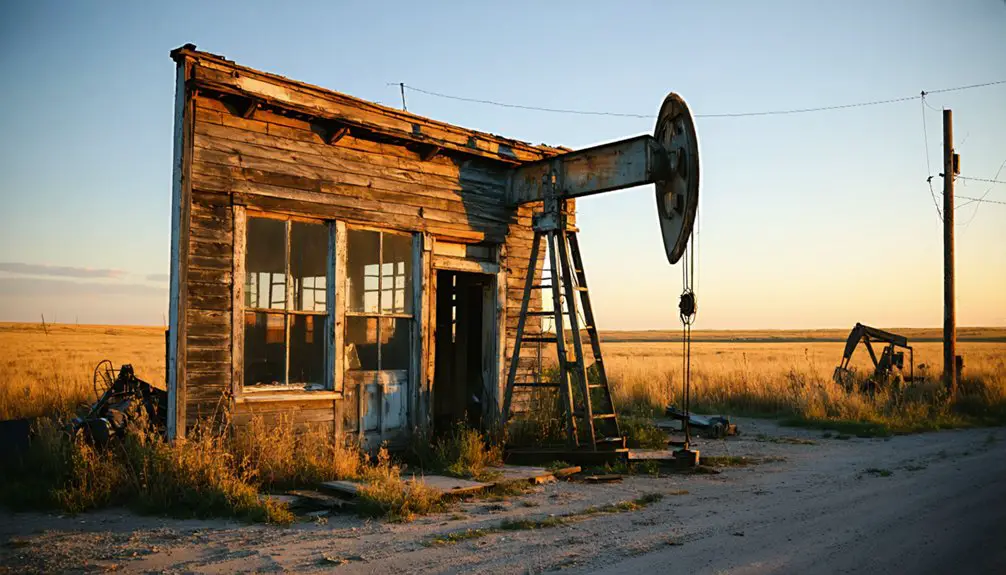
You’ll find Wheelock’s history tightly bound to the railroad, which brought both development and dramatic change to this once-thriving prairie town in eastern Williams County.
As the railroad attracted settlers and spurred business growth through the early 1900s, it also brought darker elements including bank robberies and violent crime that would shape the town’s reputation.
The series of murders in and around Wheelock, coupled with its railroad-based economic volatility, cast a long shadow over the community’s future and contributed to its eventual decline.
Railroad Town Development
When the Great Northern Railway laid its tracks through the Dakota Territory in the late 19th century, it sparked the birth of numerous railroad towns, including Wheelock in 1902.
You’ll find that railroad expansion transformed the region, with tracks being laid at an impressive rate of 3.5 miles per day during peak construction periods. The Great Northern’s strategic placement of towns along its route wasn’t just about creating stops – it was about building thriving communities. Land grant incentives encouraged rapid development of settlements along the railway corridor.
Named after Minneapolis Tribune writer Ralph W. Wheelock, the town’s infrastructure developed around the railway, which served as its lifeline to larger markets.
You could’ve witnessed freight and passenger services connecting this small prairie town to major hubs like Minot and Williston, making it an integral part of North Dakota’s growing rail network.
Violent Crime Legacy
Despite its modest size, Wheelock harbored a dark and violent past that would ultimately contribute to its downfall. The town’s notorious history includes two horrific mass murders of families, including the Kreider tragedy where six family members were killed by a rejected suitor.
You’ll find stories of other violent crimes scattered throughout Wheelock’s timeline, from the 1907 murder of a new mother by her former lover to the brutal shooting of Ida Thorpe.
These violent crimes left an indelible mark on the community, spawning haunting legends that persist to this day. As Wheelock’s population dwindled from 400 in the 1950s to just 24 by the 1970s, the town’s reputation for violence and tragedy seemed to accelerate its decline, leading to its eventual dissolution in 1994.
Geographic and Climate Challenges
Located in northwestern North Dakota’s vast “Sea of Grass,” Wheelock faced significant geographic and climatic hurdles that ultimately contributed to its demise.
You’ll find this remote township perched at 2,392 feet above sea level, where the semi-arid climate made survival increasingly challenging for its residents. Geographic isolation, 19 miles from Williston, meant limited access to resources and opportunities.
The harsh reality of prairie life took its toll – cold winters, dry summers, and insufficient rainfall made farming precarious at best. The climate impact was undeniable as water scarcity and poor soil conditions led to crop failures.
You can still see how these environmental pressures forced families to abandon their dreams, as Wheelock’s population dwindled from 115 in the 1930s to complete disincorporation by 1994.
From Bustling Hub to Ghost Town
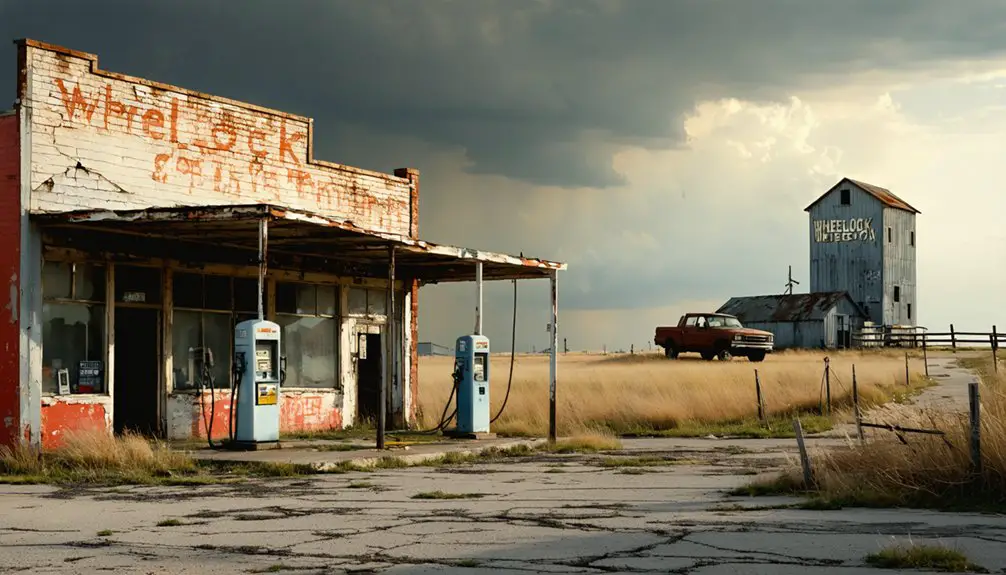
As Wheelock emerged in 1901, you’d hardly believe this bustling railroad town would meet such a dramatic fate.
At its peak, you’d find 400 residents enjoying prosperity through a thriving business district, complete with a bank, hardware store, and lumberyard.
The vibrant streets hummed with 400 souls as merchants prospered, their stores serving as anchors of small-town commerce.
But beneath the surface, dark forces challenged the community’s resilience. A series of violent incidents, including murders and a chilling bank robbery, began to erode the town’s social fabric.
Migration patterns shifted as high property costs forced settlers to seek affordable alternatives in nearby Epping. By the 1970s, the population had plummeted to just 24 people.
The final chapter came in 1994 with formal disincorporation, leaving only deteriorating structures and active railroad tracks as evidence of Wheelock’s former glory.
The Legacy of a Lost Community
While Wheelock’s physical structures may lie in ruins today, the town’s haunting legacy continues to captivate North Dakota’s collective memory.
You’ll find a story of community resilience in its rise from a railroad stop to a thriving hub of 400 residents, followed by its dramatic decline and ultimate dissolution in 1994.
The town’s cultural remembrance is deeply intertwined with its darker history – a series of violent crimes and tragic events that have earned Wheelock its reputation as one of North Dakota’s most haunted locations.
The Lakota Sioux’s ancient warning of “Maco Sica” (Bad Land) seems prophetic in hindsight.
Though the BNSF trains still rumble through, they pass only weathered remnants of barns and the old schoolhouse, silent witnesses to a community that once pulsed with life.
Frequently Asked Questions
Are There Any Living Descendants of Original Wheelock Settlers Still in the Area?
You’ll find descendant stories and family connections are hard to verify, but some residents remain in the area, including younger adults who’ve renovated old structures, suggesting possible ancestral ties.
What Happened to the Bank’s Assets When Wheelock Was Disincorporated?
In a massive financial shuffle, you’ll find that bank liquidation followed state protocols – with assets distributed back to North Dakota’s general fund through the Bank of North Dakota’s established procedures.
Can Visitors Legally Explore the Abandoned Buildings in Wheelock Today?
You can’t legally enter abandoned buildings in Wheelock without property owners’ permission. Urban exploration here faces strict legal restrictions since these structures remain private property despite their abandoned appearance.
Were Native American Artifacts Ever Discovered During Wheelock’s Development?
You won’t find records of artifact discoveries during Wheelock’s development, though the region’s cultural significance to Native Americans is well-documented through archaeological findings elsewhere in North Dakota’s Missouri River corridor.
Did Any Famous People or Notable Historical Figures Ever Visit Wheelock?
You won’t find records of any famous visitors to this remote railroad stop. While the town held local historical significance, it never attracted nationally or internationally recognized figures during its existence.
References
- https://www.beautifulbadlandsnd.com/2-madmen-2-mass-murders-in-wild-west/
- https://www.beautifulbadlandsnd.com/3-of-the-most-spooky-places-to-visit-in-the-badlands/
- https://en.wikipedia.org/wiki/Wheelock
- https://www.onlyinyourstate.com/experiences/north-dakota/ghost-towns-nd
- https://freepages.history.rootsweb.com/~gtusa/usa/nd.htm
- https://kids.kiddle.co/Wheelock
- https://northdakota365.wordpress.com/category/north-dakota/page/3/
- https://northdakota365.wordpress.com/2016/10/31/theres-a-reason-for-ghostly-wheelock/
- https://commons.und.edu/cgi/viewcontent.cgi?filename=9&article=1000&context=oers&type=additional
- https://www.history.nd.gov/ndhistory/settlement.html
